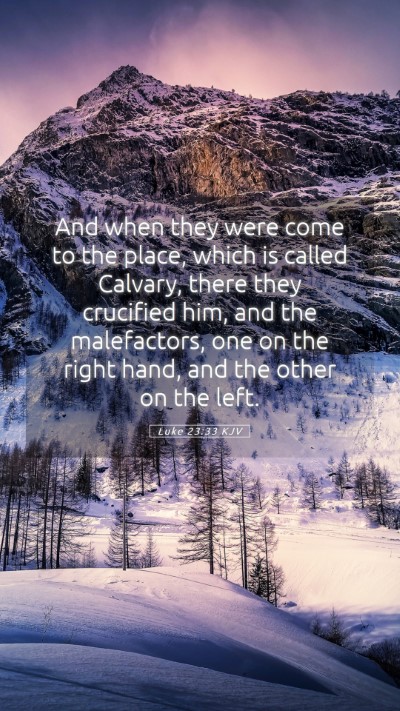Understanding Luke 23:33
In this comprehensive analysis, we will delve into Luke 23:33, which reads: "And when they were come to the place, which is called Calvary, there they crucified Him, and the malefactors, one on the right hand, and the other on the left." This verse marks a crucial moment in the New Testament, where Jesus is crucified alongside criminals, emphasizing His role as the Savior bearing the sins of humanity.
Bible Verse Meanings
This verse has been analyzed by various commentators, providing insights into its profound meaning:
-
Matthew Henry: He emphasizes that the crucifixion of Christ was prophesied and fulfills the Scriptures. By mentioning the location, Calvary (Golgotha), Henry points out the historical necessity of the site for the fulfillment of Old Testament prophecies regarding the suffering Messiah.
-
Albert Barnes: Barnes focuses on the significance of the malefactors beside Jesus. He notes that one represents the unrepentant sinner, and the other serves as a model of repentance. This juxtaposition illustrates the broader themes of justice, mercy, and redemption available through Christ.
-
Adam Clarke: Clarke reflects on the physical and spiritual aspects of the crucifixion. He highlights the brutal nature of Roman execution methods and contrasts this with the divine purpose behind Jesus’ suffering. Clarke stresses that, although Jesus suffered intensely, this act was the culmination of divine love and sacrifice.
Historical Context
Understanding the historical context of Luke 23:33 is essential for a thorough interpretation. The crucifixion occurred under Roman authority and serves as a fulfillment of the Jewish prophecies regarding the Messiah. The choice of Golgotha, known as the place of the skull, is both literal and symbolic, representing death and the dark aspect of sin.
Bible Verse Interpretations and Commentaries
Various commentaries expand on how this verse contributes to overall theological themes:
-
Salvation through Sacrifice: Jesus' crucifixion exemplifies the ultimate sacrifice, underscoring Christian beliefs about atonement and salvation. The placement between two criminals highlights His identification with sinners and His role as a mediator.
-
Theological Reflection: The act of crucifixion points to the reality of sin and its consequences. Commentaries suggest that through His suffering, Jesus willingly confronted the weight of humanity's sins, thereby offering redemption to all who believe.
Application to Daily Life
Navigating the weight of Luke 23:33 offers invaluable Bible study insights. Here are practical applications:
-
Understanding Suffering: Recognize that suffering can have a purpose. Just as Christ's suffering was necessary for redemption, our trials can be transformative when viewed through a lens of faith.
-
Embracing Redemption: The juxtaposition of the malefactors serves as a reminder of the opportunity for repentance and forgiveness offered to all. It invites believers to reflect on their own lives and seek continual reconciliation with God.
-
Sharing the Gospel: The crucifixion is central to the Christian message. Christians are called to share the significance of Jesus’ death and resurrection, emphasizing the hope and salvation that comes through belief in Him.
Bible Cross References
For a deeper understanding, consider these cross-references:
- Isaiah 53:5 - A prophetic reference to the suffering and sacrifice of the Messiah.
- John 19:18 - The account of the crucifixion, further detailing the event.
- Matthew 27:38 - The inclusion of the two thieves, aligning with Luke's account.
Conclusion
Luke 23:33 encapsulates the profound moment of Jesus' crucifixion, intertwined with deep theological implications and practical applications for believers. By exploring Bible verse explanations and interpretations, individuals can gain a more robust understanding of Scripture, ultimately enriching their faith and encouraging deeper reflections on the life and sacrifice of Christ.


